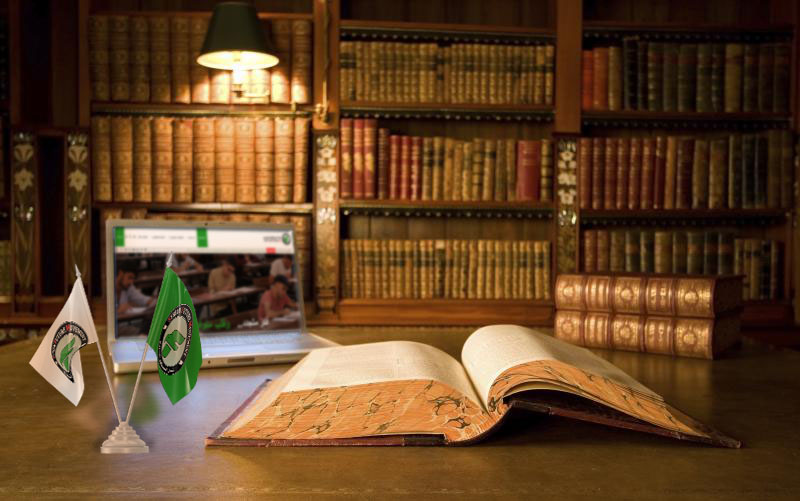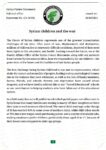Highlighting Children’s Rights in International Law

Every morning, we receive news about the ongoing war in Syria, continuous massacres, torture, and horrific executions, as well as the displacement of civilians and the involvement of children in hostile actions directly or indirectly. These actions are illegal and constitute clear violations of internationally recognized laws known as International Humanitarian Law. This law, along with international instruments, aims to ensure that humans are treated humanely in all circumstances during war, without any adverse discrimination based on race, color, religion, belief, gender, birth, wealth, or any other criteria. This law has evolved thanks to what is known as the Geneva Conventions, which include rules and international protocols under the auspices of the International Committee of the Red Cross, primarily concerned with protecting war victims, as well as The Hague Law, which deals with the outcomes of peace conferences held in the capital of the Netherlands and primarily addresses the permissible methods and means of warfare. Furthermore, efforts by the United Nations aim to ensure respect for human rights during armed conflicts and limit the use of certain weapons that disregard human dignity. It can be said that today’s International Humanitarian Law is based on an international legal framework related to international instruments within the United Nations framework and The Geneva and The Hague Laws.
Despite the existence of numerous laws and legal rules that include protection for children and women during armed conflicts, as outlined in the Geneva Conventions and the two additional protocols, these are often breached and not implemented by the parties to the conflict, with Syria being a prime example.
Description of the Conflict in Syria:
Legally, the conflict in Syria is described under the category of “internal conflicts,” which means conflicts that arise within a state and are generally subject to the rules of domestic law, with no concern for other countries. Traditional international law adopted the principle of non-intervention in civil wars, as reflected in the 1955 Institute of International Law’s regulation on the rights and duties of foreign states and their nationals in the event of rebellion against the recognized existing governments. Foreign states must respect the legitimate government as the sole representative of the state, and the state in conflict with the rebels may recognize them as combatants. However, in recent years, there has been a need to criminalize violations committed during internal armed conflicts. Article (5) of the Rome Statute of the International Criminal Court explicitly granted the Court the authority to consider crimes against humanity when committed during an armed conflict, whether international or internal, directed against civilians. The 1998 Rome Statute of the International Criminal Court explicitly stipulated the punishment for war crimes, whether in international or internal armed conflicts. This convergence resulted from the tragic outcomes of non-international armed conflicts in the former Yugoslavia and Rwanda, which exceeded many international armed conflicts in severity. Article (3) of Protocol II, in its first sentence, mentions non-international armed conflicts occurring in the territories of one of the High Contracting Parties and requires each party to the conflict to apply its provisions.
Laws Protecting Children in Times of War:
As vulnerable individuals during armed conflicts, children receive protection, which is of two types:
- General protection for civilians, ensured by the Fourth Geneva Convention and Protocol I of 1977, from which children benefit as civilians.
- Special protection provided by the Convention and Protocol I due to their vulnerable status.
However, the specific protection for children has several observations: The Fourth Geneva Convention and Protocol I of 1977 did not define the child protected under their specific provisions. Also, the age ranges taken by both vary in different cases involving children. Sometimes, specific texts refer to children under the age of 15, elsewhere to newborn children, and in other cases, they decide not to impose certain punishments on children under the age of 18. Therefore, the age ranges differ based on the cases they address. Examples of the protection provided by International Humanitarian Law include that parties to the conflict must allow the passage of essential food and clothing for children under 15 years old, and take necessary measures to ensure that children under 15 who have been orphaned or separated from their families are cared for, practice their religion, and receive education at all times. If the children are foreigners present in the territory of one of the parties to the conflict, International Humanitarian Law emphasizes that these children under 15 must benefit from any preferential treatment granted to the nationals of the concerned state. If the parties to the conflict decide to establish and organize hospital and safety zones during hostilities or established them during peacetime, among those benefiting from the protection provided by these zones are children under 15 years old, who can be admitted to these zones. Additionally, a rule requires providing additional food to detainees in specified categories, including children under 15 years old. Alongside these provisions, there are texts that refer to granting protection to children without mentioning their ages, such as the provision that obligates the occupying power to ensure, with the assistance of local authorities, the proper functioning of institutions dedicated to caring for children and taking necessary measures to facilitate the identification and registration of their parentage, prohibiting changing their nationality or enlisting them in formations or organizations affiliated with it. Moreover, it must take measures to secure the maintenance and education of children orphaned or separated from their families due to the war if local institutions are unable to do so, regardless of the child’s age.
Despite all this, it is necessary to emphasize what was stipulated in Protocol I, which added new provisions ensuring more protection for children suffering from armed conflict conditions. It stated: “Children shall be the object of special respect and shall be protected against any form of indecent assault. The parties to the conflict shall provide them with the care and aid they require, whether because of their age or for any other reason.” This was followed by other texts ensuring the child’s protection from certain actions, such as prohibiting the recruitment of children under 15 years old, especially prohibiting their direct participation in hostilities, which requires the parties to the conflict to take necessary measures to ensure this. Additionally, these parties must refrain from recruiting these children into their armed forces. In another instance, children are mentioned without specifying their ages. If children are captured and detained or imprisoned for reasons related to the armed conflict, the parties to the conflict must place them in separate quarters from adults, except in cases where family units are accommodated. The protocol raised the child’s age to 18, prohibiting the execution of those who had not yet reached the age of 18 at the time of the offense. In another provision, the protocol included newborns under the term “wounded and sick,” granting them the right to benefit from the provisions for providing treatment and assistance to the wounded and sick. It also stipulated that the parties to the conflict refrain from executing mothers of young children who depend on them, to provide the necessary care for these children who cannot care for themselves. The protocol also specified measures to be followed when evacuating children who are not nationals of the parties to the conflict or the occupying state.
International efforts have continued to study the topic of children’s rights that should be protected at all times, culminating in the Convention on the Rights of the Child, which, on one hand, defines who is a child and, on the other hand, states the specific provisions regarding children who may face armed conflict conditions. The Convention on the Rights of the Child, part of International Human Rights Law, defines a child as “every human being below the age of eighteen unless, under the law applicable to the child, majority is attained earlier.” Additionally, a special protocol on the rights of the child addresses the involvement of children in armed conflicts. The Optional Protocol to the Convention on the Rights of the Child on the involvement of children in armed conflict, adopted by General Assembly resolution 263 in its 54th session on May 25, 2000, and in force since 2002, included these provisions:
- States Parties shall take all feasible measures to ensure that members of their armed forces who have not attained the age of 18 do not take a direct part in hostilities.
- States Parties shall ensure that persons who have not attained the age of 18 are not compulsorily recruited into their armed forces.
- States Parties shall raise the minimum age for voluntary recruitment into their national armed forces from the age set out in article 38, paragraph 3, of the Convention on the Rights of the Child, taking into account the principles contained in that article and recognizing the right of persons under 18 to special protection under the Convention. Each State Party shall deposit a binding declaration upon ratification of or accession to this Protocol that sets forth the minimum age at which it will permit voluntary recruitment into its national armed forces and a description of the safeguards it has adopted to ensure that such recruitment is not forced or coerced. These safeguards include:
- Ensuring the voluntary nature of recruitment.
- Obtaining parental or guardian consent.
- Providing information on the duties involved in military service.
- Verifying the age of the voluntary recruit.
Thus, the difference arises between the provisions of this protocol and the provisions of International Humanitarian Law and human rights related to the child in the context of armed conflicts. International Humanitarian Law provisions, especially those determining the child’s age for direct involvement in hostilities, refer to the age of 15, allowing recruitment of those who have reached this age by parties to the armed conflict, without specifying whether they volunteered or were forced. The protocol, however, distinguishes between voluntary service, which is the only permissible condition, requiring the child to be at least 15 years old, and compulsory or forced recruitment, which is prohibited for children under 18 years old. The protocol also emphasizes that states should take measures to prevent the involvement of children under 18 in hostilities and to ensure that any recruitment of children under 18 is truly voluntary, with parental or guardian consent and not coerced.
Conclusion:
From here, it is clear that all the aforementioned provisions are more effective in protecting children from actually being involved in conflicts as soldiers or participants in hostilities. This focus by international human rights law on children’s rights during armed conflicts highlights the complementarity between international humanitarian law and international human rights law. The latter fills the gaps and shortcomings in protection found in the former. From here, the importance of protecting children in international law also becomes evident, and this is what we at the Family Affairs Office of the Syrian Future Movement (SFM) aim to shed light on. We strive to reveal to Syrians the human rights reality and its connection to international law, and to renew interest in it, especially concerning the most vulnerable groups, such as children.
Therefore, at the Family Affairs Office of the Syrian Future Movement (SFM), we call for the teaching of international law in all its forms in Syrian schools, institutes, and universities. We advocate for spreading human rights culture as an alternative to the culture of brutality or indifference to rights.
Waheba Al-Masri
Family Affairs Office
Research and Studies Department
Syrian Future Movement (SFM)
References:
- Dr. Israa Alaa Al-Din Nouri, “The Reality of Children’s and Women’s Rights in Times of Armed Conflicts,” Al-Nahrain Studies Center, unpublished.
- Dr. Ahmed Zaki Badawi, “Dictionary of Political and International Terms,” 1st ed., (Cairo, Egyptian Book House, 1989), p. 73.
- Amohamed Barada Ghaziyoul, “The Concept of International Humanitarian Law and the Areas of Legal Protection it Includes,” published online: ma.courappelfes.www://h
- Dr. Mufid Mahmoud Shihab, “Studies in International Humanitarian Law,” 1st ed., Arab Future House, Cairo, 2000, p. 143.
- Introduction to the Optional Protocol to the Convention on the Rights of the Child on the Involvement of Children in Armed Conflict, adopted by General Assembly resolution No. 263 at its 54th session on May 25, 2000, and entered into force in 2002.






